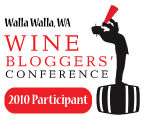 I had the opportunity to spend five days in Virginia last month. Part of it was for the Drink Local Wine 2010 Conference and part was to talk to about 25 Virginia wineries about customer service & etiquette in social media. I roamed the rolling hills of Virginia in search of wineries and stopped in at
I had the opportunity to spend five days in Virginia last month. Part of it was for the Drink Local Wine 2010 Conference and part was to talk to about 25 Virginia wineries about customer service & etiquette in social media. I roamed the rolling hills of Virginia in search of wineries and stopped in at  Chrysalis Vineyards, Doukenie Winery, and Breaux Vineyards. I wish I would have had more time to visit at each winery. I was extremely lucky to do most of a Nebbiolo tasting at Breaux but had to dash out to make a winemaker dinner. I know you
Chrysalis Vineyards, Doukenie Winery, and Breaux Vineyards. I wish I would have had more time to visit at each winery. I was extremely lucky to do most of a Nebbiolo tasting at Breaux but had to dash out to make a winemaker dinner. I know you  are feeling so sorry for me right about now. What was really interesting was that I tried a few varietals that I had not had including Norton, Tannat, and Petit Manseng.
are feeling so sorry for me right about now. What was really interesting was that I tried a few varietals that I had not had including Norton, Tannat, and Petit Manseng.
Virginia Wine is poised to make a big leap with promoting their wineries. They are making some very nice wines and are interested in moving forward and want to be recognized for their efforts.
Virginia Wne History
Virginians have made wine for more than four centuries. The Jamestown settlers had such hopes that Virginia would become a major source of wine for the British Empire that in 1619 they signed into law a requirement for each male settler to plant and tend at least ten grape vines. Little came of it. Every effort to grow vinifera, or vines of European origin, met with failure from an unknown pest, Phylloxera as well as diseases in a new environment. The booming tobacco trade diluted British interest in the possibilities of American wine. Americans themselves lost interest. While fine wine could be had only from Europe, whiskey, beer and brandy were plentiful.
In hopes of one day realizing the promise of fine Virginia wines, Thomas Jefferson cultivated European grapes for more than 30 years. His Monticello vineyards never produced a single bottle of wine from his years of vineyard trials. He wasn’t alone in trying. After 11 years of efforts at Mount Vernon, George Washington, too, had nothing to show for it.
In the 1820s, wines made from Native American grapes met with great success. Then a Virginia Norton wine was named “best red wine of all nations” at the Vienna World’s Fair in 1873. Plus a gold medal for Norton at the Paris World’s Fair of 1889 when the Eiffel tower was constructed. The discovery in the late 1800s that native and European vines could be grafted gave Virginia’s nascent wine industry a lift – but in the early 20th century, Prohibition promptly brought it to a standstill. The industry was slow to bounce back. Some 17 years after Prohibition’s repeal, Virginia had all of 15 acres of commercial wine grapes.
In the late-1950s, experimental plantings of vinifera showed promise. With the establishment of six new wineries in the 1970s, the recovery was officially underway. A renewed effort to grow a European Chardonnay succeeded at the Waverly Estate in Middleburg in 1973. Then in 1976, Italian pioneer vintner Gianni Zonin hired Gabriele Rausse to grow and harvest vinifera grapes near Charlottesville. He established Barboursville Vineyards and then helped other vineyards do the same. By 1995, Virginia had 46 wineries. By 2005, 107. At 140 wineries and counting today, only California, New York, Oregon and Washington have more wineries than Virginia. The persistence of generations of winemakers is paying off. And the vision of one of Virginia’s most renowned native sons, Thomas Jefferson, is now coming true

{ 1 comment… read it below or add one }
Annette Boyd 06.03.10 at 7:17 pm
Shona – Thanks for the article. It was great to have you in Virginia. Stay in touch. I hope to make it wo Washington sometime to expereince Washinton wineries.